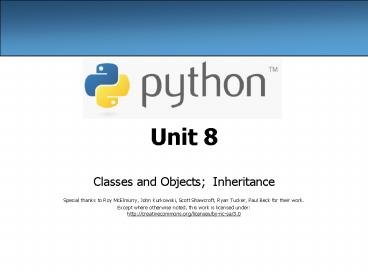Classes and Objects; Inheritance - PowerPoint PPT Presentation
Title:
Classes and Objects; Inheritance
Description:
Slides used in the University of Washington's CSE 142 Python sessions. – PowerPoint PPT presentation
Number of Views:156
Avg rating:3.0/5.0
Title: Classes and Objects; Inheritance
1
Unit 8
- Classes and Objects Inheritance
- Special thanks to Roy McElmurry, John Kurkowski,
Scott Shawcroft, Ryan Tucker, Paul Beck for their
work. - Except where otherwise noted, this work is
licensed underhttp//creativecommons.org/license
s/by-nc-sa/3.0
2
OOP, Defining a Class
- Python was built as a procedural language
- OOP exists and works fine, but feels a bit more
"tacked on" - Java probably does classes better than Python
(gasp) - Declaring a class
- class name
- statements
3
Fields
- name value
- Example
- class Point
- x 0
- y 0
- main
- p1 Point()
- p1.x 2
- p1.y -5
- can be declared directly inside class (as shown
here)or in constructors (more common) - Python does not really have encapsulation or
private fields - relies on caller to "be nice" and not mess with
objects' contents
point.py point.py
1 2 3 class Point x 0 y 0
4
Using a Class
- import class
- client programs must import the classes they use
point_main.py point_main.py
1 2 3 4 5 6 7 8 9 10 from Point import main p1 Point() p1.x 7 p1.y -3 ... Python objects are dynamic (can add fields any time!) p1.name "Tyler Durden"
5
Object Methods
- def name(self, parameter, ..., parameter)
- statements
- self must be the first parameter to any object
method - represents the "implicit parameter" (this in
Java) - must access the object's fields through the self
reference - class Point
- def translate(self, dx, dy)
- self.x dx
- self.y dy
- ...
6
"Implicit" Parameter (self)
- Java this, implicit
- public void translate(int dx, int dy)
- x dx // this.x dx
- y dy // this.y dy
- Python self, explicit
- def translate(self, dx, dy)
- self.x dx
- self.y dy
- Exercise Write distance, set_location, and
distance_from_origin methods.
7
Exercise Answer
point.py point.py
1 2 3 4 5 6 7 8 9 10 11 12 13 14 15 16 17 from math import class Point x 0 y 0 def set_location(self, x, y) self.x x self.y y def distance_from_origin(self) return sqrt(self.x self.x self.y self.y) def distance(self, other) dx self.x - other.x dy self.y - other.y return sqrt(dx dx dy dy)
8
Calling Methods
- A client can call the methods of an object in two
ways - (the value of self can be an implicit or explicit
parameter) - 1) object.method(parameters)
- or
- 2) Class.method(object, parameters)
- Example
- p Point(3, -4)
- p.translate(1, 5)
- Point.translate(p, 1, 5)
9
Constructors
- def __init__(self, parameter, ..., parameter)
- statements
- a constructor is a special method with the name
__init__ - Example
- class Point
- def __init__(self, x, y)
- self.x x
- self.y y
- ...
- How would we make it possible to construct a
Point() with no parameters to get (0, 0)?
10
toString and __str__
- def __str__(self)
- return string
- equivalent to Java's toString (converts object to
a string) - invoked automatically when str or print is called
- Exercise Write a __str__ method for Point
objects that returns strings like "(3, -14)" - def __str__(self)
- return "(" str(self.x) ", " str(self.y)
")"
11
Complete Point Class
point.py point.py
1 2 3 4 5 6 7 8 9 10 11 12 13 14 15 16 17 18 19 20 21 from math import class Point def __init__(self, x, y) self.x x self.y y def distance_from_origin(self) return sqrt(self.x self.x self.y self.y) def distance(self, other) dx self.x - other.x dy self.y - other.y return sqrt(dx dx dy dy) def translate(self, dx, dy) self.x dx self.y dy def __str__(self) return "(" str(self.x) ", " str(self.y) ")"
12
Operator Overloading
- operator overloading You can define functions so
that Python's built-in operators can be used with
your class. - See also http//docs.python.org/ref/customization
.html
Operator Class Method
- __neg__(self, other)
__pos__(self, other)
__mul__(self, other)
/ __truediv__(self, other)
Operator Class Method
__eq__(self, other)
! __ne__(self, other)
lt __lt__(self, other)
gt __gt__(self, other)
lt __le__(self, other)
gt __ge__(self, other)
Unary Operators
- __neg__(self)
__pos__(self)
13
Exercise
- Exercise Write a Fraction class to represent
rational numbers like 1/2 and -3/8. - Fractions should always be stored in reduced
form for example, store 4/12 as 1/3 and 6/-9 as
-2/3. - Hint A GCD (greatest common divisor) function
may help. - Define add and multiply methods that accept
another Fraction as a parameter and modify the
existing Fraction by adding/multiplying it by
that parameter. - Define , , , and lt operators.
14
Generating Exceptions
- raise ExceptionType("message")
- useful when the client uses your object
improperly - types ArithmeticError, AssertionError,
IndexError, NameError, SyntaxError, TypeError,
ValueError - Example
- class BankAccount
- ...
- def deposit(self, amount)
- if amount lt 0
- raise ValueError("negative amount")
- ...
15
Inheritance
- class name(superclass)
- statements
- Example
- class Point3D(Point) Point3D extends Point
- z 0
- ...
- Python also supports multiple inheritance
- class name(superclass, ..., superclass)
- statements
- (if gt 1 superclass has the same field/method,
conflicts are resolved in left-to-right order)
16
Calling Superclass Methods
- methods class.method(object, parameters)
- constructors class.__init__(parameters)
- class Point3D(Point)
- z 0
- def __init__(self, x, y, z)
- Point.__init__(self, x, y)
- self.z z
- def translate(self, dx, dy, dz)
- Point.translate(self, dx, dy)
- self.z dz































